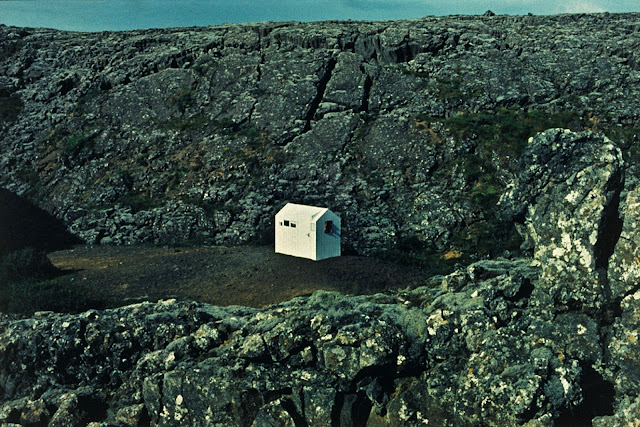Hafnarborg - Centre of Culture and
Fine Art in Hafnarfjördur, Iceland
May 12 – August 19, 2012
May 12 – August 19, 2012
 |
| Hreinn Friðfinnsson, House Project, 1974. Courtesy of the artist and i8 Gallery |
Being abroad it can be fascinating to hear how people imagine your home place to be and to see the reality-creating effects of these imaginations. In the Icelandic paper I read A Day in the Life of the blogger Alda Sigmundsdóttir. In the afternoon Alda Sigmundsdóttir likes to chill at Kaffismđjan in Reykjavik, which makes her feel “like I'm a cool bohemian hanging out at a café in Berlin.” Curious to know what that' s like I went there together with two other Berliners, Wolfgang Müller and Stefan Juliusson, on a Monday afternoon. Unfortunately the café was closed – an arbitrariness in opening hours that stroke us indeed as typically Berlin. One block further at Skólavördustigur we came upon the roof café Babalú and we ended up getting the authentic Berlin experience anyhow. The bartender was German-speaking and barked at us in Schnauzer-style. She ruined our good mood and we felt far from being bohemian. The day before I had encountered my other Heimat in a similarly unpleasant way. Sitting in a bar I was confronted with a young and hansom Belgian man telling a woman about the political situation in Belgium in a most simplifying way. There is an excellent German word for the painful condition I was in: it's called fremdschämen.
There are some things that are
inexplicable about a country, for instance why Brussels has a little
peeing man as a symbol. That's what Wolfgang Müller answered me when
asking him about the phenomenon of hringurinn – the driving
around in circles. He wrote about hringurrin in his book Blue
Tit. Das deutsch-isländische Blaumeisenbuch. In Reykjavik, on
Saturday nights, people polish up their cars, or even better jeeps,
and drive down the main shopping street Laugavegur to the downtown
square past the parliament and back up the hill. This track is
repeated again and again. It is an activity you don't want to do on
your own unless you are a pervert or an egoist, so it was explained
to me. You go with your family or friends and drive slowly; it's the
game of seeing and being seen. To have a nice car is of high
importance in Iceland. The artist Ásta Ólafsdóttir told me that
many icelanders are driven by two ambitions: buying a car and
building a house.
 In 2012 the German hardware store Bauhaus opened in Reykjavik. Six percent of Iceland's population visited the store on the opening day. People even camped outside the night before the opening. |
Hafnarborg - the Hafnarfjördur Centre of Culture and Fine Art is showing an exhibition titled Hús (House). Hafnarfjördur is a port city near Reykjavik, built on lava ground. It is in this region that elves are believed to have their homes in boulders. On show at Hafnarborg are three houses that also merge fiction and reality. The houses were constructed by and documented through photos by the Icelandic artist Hrein Friđfinnsonn. In the House Project Hrein Friiđfinnsonn negotiates the relationship between inside and outside, interior and exterior, domestic and public, home and abroad. The three houses destabilize in different ways the human urge to distinguish oneself from an outside, from that what is considered to be foreign in order to create a sense of self.
Friđfinnsonn's
House Project is inspired by the 1938 novel Icelandic
Aristocracy by Pórbergur Pórdarson. It tells the story of Sólon
Gudmundsson, a free spirit who in older age sold his house in order
to build a small one, but then inside out. The iron sheets were
supposed to be inside whereas the wallpaper on the outside was for
everyone to enjoy. Gudmundsson never made it but Friđfinnsonn
did in 1974, building the house in a desolated area near
Hafnarfjördur. Its desolateness might have been chosen to heighten
the greater realm of the House Project. It
can be seen as a subversion of both bourgeois and modernist
architecture and world views – an anarchitecture similar to
Gordon's Matta-Clark's. In the First House the outside is
enclosed by the four walls and the roof. The inside serves as the
shelter for the whole world, except for itself.
In 2008, Second House was
constructed in France, now reversed and thus turned back to normal:
the outside facing the external, the inside facing the internal. From
the windows the visitor can see three photographs of the first house
and a miniature model of its skeleton made out of metal wire and
placed on a meteor hovering in the air above a mirror. The universe
is brought into the house, and found shelter together with First
House. The transformation of the First House into a metal
skeleton in the Second House is a forebode of the Third
House. Build from
stainless steel on a hill outside of Hafnarfjördur the Third
House consists only of a framework. Interior and exterior have
been dissolved. Yet, their invisibility does not mean they are
absent. “Every soul,” the artist writes, “should feel the
difference between standing within the house or outside of it.” The
Third House is there to stay until even the steel frames, subject
to weather conditions, will waste away. The final result of
Friđfinnsonn's House
Project is no house.
The book House Project - First House / Second House / Third House is published by Hafnarborg and Crymogea publishing (http://www.crymogea.is/). Wolfgang Müller's Blue Tit book, in German and Icelandic translation, was published in 1997 by Martin Schmitz Verlag (http://www.martin-schmitz-verlag.de/Wolfgang_Mueller/Buch.html). About Hafnarborg:
http://en.hafnarborg.is